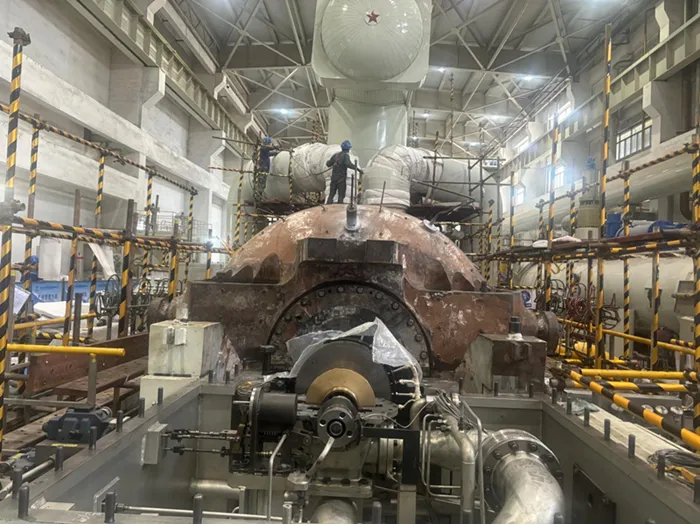Key points for overhaul and maintenance of steam turbines should focus on the overhaul and maintenance of the oil system, the speed control system, and the bearing system. Focusing on key areas for targeted overhaul and maintenance will promote the healthy development of the nation's power supply sector.
1. The Value of Overhaul and Maintenance of Power Plant Steam Turbines
Power plant steam turbines are crucial equipment for power plant operations and serve as the primary source of power. Because power plants operate continuously, any failure will directly impact normal power supply. Therefore, prioritizing the overhaul and maintenance of power plant steam turbines is essential. During operation, power plant steam turbines rely on scientific, rigorous, and effective overhaul and maintenance techniques. Only through a comprehensive and meticulous overhaul process can potential faults be eliminated and proper operation of the power plant maintained. During the inspection and maintenance of steam turbines in power plants, relevant personnel should combine the operating principles of steam turbines, master the internal structure of steam turbines, and make connections between fault types and manifestations, so as to promptly and accurately determine the location and cause of fault hazards and improve the quality of steam turbine inspection and maintenance. During the operation of steam turbines in power plants, due to the influence of factors such as high temperature and wear, the fault manifestations are mainly concentrated in the steam turbine condenser, steam turbine regulating system, steam turbine main shaft and cylinder. These parts are the core structure of the steam turbine and are also the parts that are more easily damaged. During the inspection and maintenance of steam turbines, it is necessary to conduct inspections based on key structural parts and solve them in a targeted manner based on the inspection and maintenance technology, so as to ensure the safe and stable operation of the power plant generator set.
2. Common Steam Turbine Failures
2.1 Turbine Blade Damage
Turbine blade damage, aging, and failure are often caused by prolonged service, poor operating conditions, and a lack of regular maintenance and inspection. Blade damage is primarily caused by two factors: First, blade condition. Large temperature differences, operating conditions, steam shock, and improper operator adjustments are all major contributors to blade damage. Second, the equipment itself. If proper procedures are not followed during the blade manufacturing process, resulting in substandard blade quality, blade damage will inevitably occur during turbine operation. Blade failures can cause friction between the turbine's moving and static components, significantly reducing turbine safety and shortening the service life of the entire equipment.
2.2 Water Shock
During turbine operation, improper operation can allow large amounts of water vapor or hydrophobic water to enter the turbine, causing a sudden drop in temperature and a significant temperature difference. This can lead to severe water shock, a potentially fatal blow to the turbine. Because the existence of this problem can cause blade damage and deformation, the internal structure of the steam turbine will also be severely damaged, and even the entire steam turbine will be in danger of being scrapped.
2.3 Reduced Vacuum of Steam Turbine
The reduction of steam turbine vacuum has the following three reasons: (1) If the circulating water volume is insufficient, the circulating water pump cannot operate normally, which will directly lead to a decrease in the condenser vacuum, causing the steam turbine to be unable to operate normally. (2) When the steam turbine is operating normally, the circulating water temperature of the circulating water pump suddenly rises, which will directly cause the vacuum of the steam turbine to decrease. (3) If there is a problem with the outlet pressure of the circulating water pump, the vacuum of the steam turbine will also tend to decrease. During the normal operation of the steam turbine, the interior of the steam turbine cylinder should be in a sealed state. If the vacuum of the condenser decreases, the efficiency of the steam turbine will be reduced, and even a shutdown accident will occur.
2.4 Turbine Overspeed
The main signs of an overspeeding steam turbine during operation are as follows: First, rising values on the frequency, speed, and main oil pressure meters. Second, the power meter indicates zero. Third, unusual noises and strong vibrations are heard during operation. Generally, the overspeed limit for a steam turbine is 110%-112% of the rated speed. If an overspeed condition occurs, certain components of the turbine will be damaged, the turbine shafting may break, and a runaway turbine may occur, rendering the entire unit useless.

3. Analysis of Key Technical Points in Power Plant Steam Turbine Inspection and Maintenance 3.1 Impeller Inspection and Repair
The impeller is a vital component of the steam turbine. Its stable operation and efficiency are closely linked to the impeller, and to a certain extent, it is the guarantee of the turbine. In order to ensure that the quality of the turbine impeller meets the standards, ensure the safe operation of the impeller, and avoid safety accidents caused by impeller problems, it is necessary to conduct targeted inspections and repairs on the cracks, erosion and uneven surfaces of the turbine impeller to ensure that the impeller plays a role in the operation of the turbine.
3.2 Inspection and maintenance of abnormal noise and vibration of steam turbines The abnormal noise and vibration of steam turbines have a great impact on the coordination of various components and the overall stable operation of the steam turbine. This phenomenon is the most common phenomenon in steam turbine failures. The following are the specific manifestations of abnormal noise and vibration of steam turbines: (1) The temperature changes suddenly during the operation of the steam turbine. The temperature rises severely, causing thermal deformation of the rotor and even equipment shutdown, and the friction coefficient between the various components increases. (2) Abnormal noise, vibration and air flow oscillation of the rotor.
3.3 Inspection and maintenance of the oil system of steam turbines
During the operation of the steam turbine, the lubricating oil of the steam turbine plays the role of lubrication and cooling. If the oil temperature is too high, it cannot play the role of cooling, cannot effectively remove the heat generated by the friction between the shaft and the oil film, and even cannot effectively establish the oil film. If the oil temperature is too low, the viscosity of the oil increases, the oil film becomes thicker, and the lubrication effect of the bearing is reduced. If the oil temperature exceeds the standard temperature value, it will cause abnormalities in the oil system. In the process of dealing with these faults in the oil system, first of all, it is necessary to check the valves to avoid the problem of sticking. Secondly, it is necessary to regularly check and remove mechanical impurities in the turbine equipment and oil system to effectively avoid wear of the oil system's journals and bearings and prevent the control valve from clogging. Polishing and grinding can be used to remove impurities in the oil system.
3.4 Understand the Operation of the Entire Power Plant Steam Turbine
Turbine axial displacement changes and optimize turbine operating efficiency. First, when monitoring turbine axial displacement changes, pay attention to the specific data changes on the turbine pressure gauge. Because the pressure gauge can indicate the turbine's operating status, real-time monitoring of turbine axial displacement changes is an effective method for controlling turbine operation. Second, when monitoring overall turbine operation, the operating characteristics of the entire turbine are displayed using specific data. This facilitates comparison of the vibration frequency of the turbine bearings under high and low load conditions. Real-time monitoring of the vibration frequency allows for the detection of faulty bearings and prompt repair or replacement, further ensuring normal operation of the turbine under low load conditions.
3.5 Inspection and Maintenance of Steam Turbine Condensers
The condenser is a critical component of a power plant's steam turbine auxiliary equipment. The thermal efficiency of the turbine operation directly depends on its proper operation. Furthermore, the internal water energy consumption of the turbine unit and the proper operation of the turbine also depend on the condenser's operation. Steam turbine condenser operational failures are characterized by the following characteristics: a drop in vacuum during condenser operation, which directly leads to an increase in the unit's exhaust temperature. This increased exhaust temperature, in turn, causes excessively high circulating water temperatures. Ultimately, this sudden temperature change causes abnormal noise and vibration throughout the unit, rendering the turbine unsafe to operate.
Conclusion
Steam turbines are core equipment in power plant electricity production. Analyzing the operational status of steam turbines, to a certain extent, determines the safety and stability of power plant electricity production. Therefore, strengthening steam turbine inspection and maintenance during power plant operation is of great significance for stable electricity production and ensuring the actual profitability of power companies. In summary, the above content discusses the key technical points for the inspection and maintenance of steam turbines in power plants.
